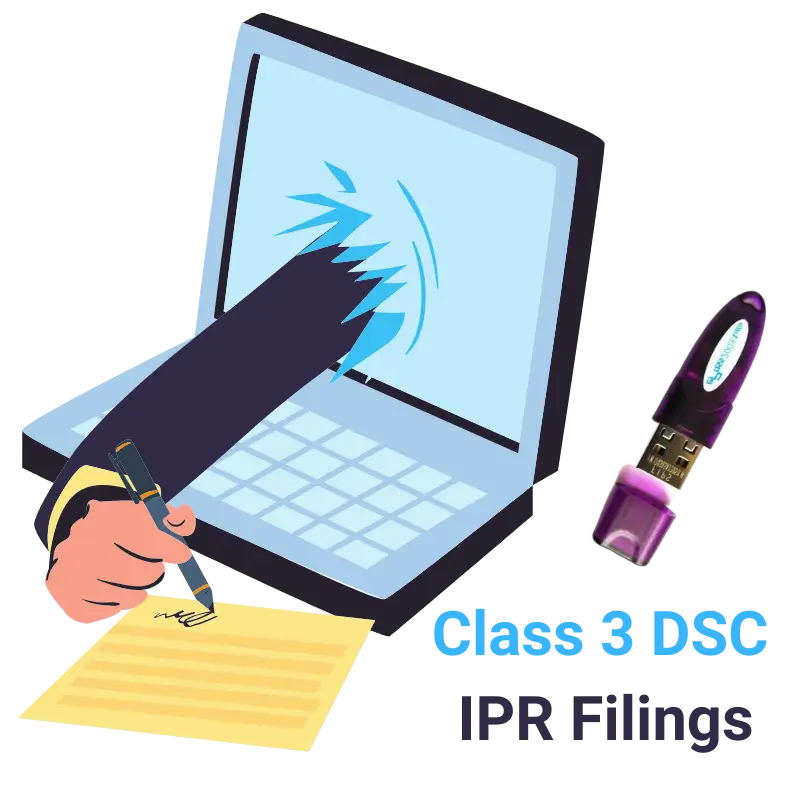Digital Signature for IPR (Trademark & Patent)
In the contemporary age of digitization and intellectual property protection, Digital Signature for IPR are the driving force to maintain security, authenticity, and legality in trademark, patent, and copyright-related electronic document processes. For companies, inventors, and legal organizations transacting in the Intellectual Property Rights (IPR) regime of India, Class 3 Digital Signature Certificate (DSC) is a mandatory requirement by law. In India, “the Patents Act” was enacted on April 20, 1972, to replace the previous Indian Patents and Designs Act, 1911. Important amendments were made by the Patents (Amendment) Acts of 2005, 2016, and 2017.
Send Your Query
Class 3 Digital Signature for IPR Filings
The Class 3 DSC for IPR is the topmost digital certificate utilised in India, providing a higher level of security and authenticity verification. It is particularly called for in case of e-filing of trademark applications, patent filings, reply filings, oppositions, and any other legitimate IP-related letters.
As per the Indian Patent Office (IPO) and Trademark Office, all users who plan to file electronically are required to use a Class 3 Digital Signature that incorporates both signing and encryption capabilities. This guarantees that
- Only authorized individuals can access and file applications.
- Submissions cannot be altered after signing.
- All filings are legally valid and enforceable.

Benefits of Using Digital Signature for IPR Filing
Digital signatures have revolutionized the filing of intellectual property rights (IPR) applications in India. Ensuring security, authenticity, and efficiency, they make trademark and patent registrations easy and cut down on delays. The government requires Class 3 DSC for all IP filings online, and hence, they are a necessity for businesses and legal professionals.
-
Prevention of Fraud
-
Faster Processing
-
Legal & Global Acceptance
A Class 3 DSC offers robust encryption, making sure that only authorized users can submit IPR applications. It avoids impersonation and tampering, lowering the chances of fraudulent patent or trademark filings. Every digital signature is specifically associated with the applicant, authenticated via Aadhaar or KYC, offering an additional layer of protection. This Information Technology Act, 2000, compliance secures sensitive intellectual property information from cyber threats.
Applicants are able to file trademark and patent applications immediately using digital signatures without paper documentation. IP India portal speeds up the processing of digitally signed applications, minimizing delays in manual verification. Lawyers and companies can monitor application status in real-time, get faster approvals, and respond to objections with ease. It saves administrative costs and storage problems as well, making IPR management easier.
The Controller General of Patents, Designs & Trademarks (CGPDTM) requires DSCs for all e-filings, keeping in mind Indian IP legislations. A digitally signed application is as legally valid as a physical signature and can be admitted in courts. Further, since international IP offices also accept digital signatures, Indian applicants can file under PCT (Patent Cooperation Treaty) or Madrid Protocol (for trademarks) with ease, ensuring protection of IPs across the world.

Trademark & Patent Registration in India
Trademark or patent registration in India gives a legal safeguard against infringement and unauthorised use. The procedure is overseen by the Controller General of Patents, Designs & Trademarks (CGPDTM) and consists of compliance with some rules as per the Trademarks Act, 1999 and Patents Act, 1970.
Trademark Registration Process
- Search & Application – Conduct a TM Public Search to check for existing trademarks, then file Form TM-A online.
- Examination – The Trademark Office reviews the application and may issue objections.
- Publication & Opposition – If approved, the mark is published in the Trademark Journal for 4 months (opposition period).
- Registration & Renewal – If unopposed, a certificate is issued, valid for 10 years (renewable indefinitely).
Patent Registration Process
Patent Search & Drafting – Conduct a prior art search and draft a complete specification (provisional or complete application).
Filing & Publication – Submit Form 1 with a DSC, followed by publication after 18 months.
Examination – A request for examination (Form 18) must be filed within 48 months.
Grant & Maintenance – If approved, the patent is granted for 20 years (renewal fees apply annually after the 3rd year).

